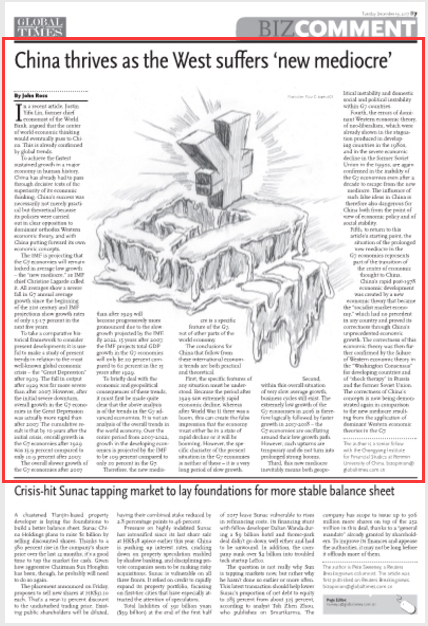Major Power Relations
Your Present Location: PROGRAMS> Major Power RelationsJohn Ross: China thrives as the West suffers `new mediocre’
By John Ross Source: Global Times Published: 2017-12-18
In a recent article, Justin Yifu Lin, former chief economist of the World Bank, argued that the center of world economic thinking would eventually pass to China. This is already confirmed by global trends.
To achieve the fastest sustained growth in a major economy in human history, China has already had to pass through decisive tests of the superiority of its economic thinking. China`s success was necessarily not merely practical but theoretical because its policies were carried out in clear opposition to dominant orthodox Western economic theory, and with China putting forward its own economic concepts.
The IMF is projecting that the G7 economies will remain locked in average low growth - the "new mediocre," as IMF chief Christine Lagarde called it. All averages show a severe fall in G7 annual average growth since the beginning of the 21st century and IMF projections show growth rates of only 1.5-1.7 percent in the next five years.
To take a comparative historical framework to consider present developments it is useful to make a study of present trends in relation to the most well-known global economic crisis - the "Great Depression" after 1929. The fall in output after 1929 was far more severe than after 2007. However, after the initial severe downturn, overall growth in the G7 economies in the Great Depression was actually more rapid than after 2007. The cumulative result is that by 10 years after the initial crisis, overall growth in the G7 economies after 1929 was 15.9 percent compared to only 10.9 percent after 2007.
The overall slower growth of the G7 economies after 2007 than after 1929 will become progressively more pronounced due to the slow growth projected by the IMF. By 2022, 15 years after 2007, the IMF projects total GDP growth in the G7 economies will only be 20 percent compared to 62 percent in the 15 years after 1929.
To briefly deal with the economic and geopolitical consequences of these trends, it must first be made quite clear that the above analysis is of the trends in the G7 advanced economies. It is not an analysis of the overall trends in the world economy. Over the entire period from 2007-2022, growth in the developing economies is projected by the IMF to be 109 percent compared to only 20 percent in the G7.
Therefore, the new mediocre is a specific feature of the G7, not of other parts of the world economy.

The conclusions for China that follow from these international economic trends are both practical and theoretical.
First, the specific features of any situation must be understood. Because the period after 1929 saw extremely rapid economic decline, whereas after World War II there was a boom, this can create the false impression that the economy must either be in a state of rapid decline or it will be booming. However, the specific character of the present situation in the G7 economies is neither of these - it is a very long period of slow growth.
Second, within this overall situation of very slow average growth, business cycles still exist. The extremely low growth of the G7 economies in 2016 is therefore logically followed by faster growth in 2017-2018 - the G7 economies are oscillating around their low growth path. However, such upturns are temporary and do not turn into prolonged strong booms.
Third, this new mediocre inevitably means both geopolitical instability and domestic social and political instability within G7 countries.
Fourth, the errors of dominant Western economic theory, of neo-liberalism, which were already shown in the stagnation produced in developing countries in the 1980s, and in the severe economic decline in the former Soviet Union in the 1990s, are again confirmed in the inability of the G7 economies even after a decade to escape from the new mediocre. The influence of such false ideas in China is therefore also dangerous for China both from the point of view of economic policy and of social stability.
Fifth, to return to this article`s starting point, the situation of the prolonged new mediocre in the G7 economies represents part of the transition of the center of economic thought to China. China`s rapid post-1978 economic development was created by a new economic theory that became the "socialist market economy," which had no precedent in any country and proved its correctness through China`s unprecedented economic growth. The correctness of this economic theory was then further confirmed by the failure of Western economic theory in the "Washington Consensus" for developing countries and of "shock therapy" in Russia and the former Soviet Union. The correctness of China`s concepts is now being demonstrated again in comparison to the new mediocre resulting from the application of dominant Western economic theories in the G7.
The author is a senior fellow with the Chongyang Institute for Financial Studies at Renmin University of China.
Key Words: China; economy; RDCY; John Ross























































































 京公网安备 11010802037854号
京公网安备 11010802037854号





